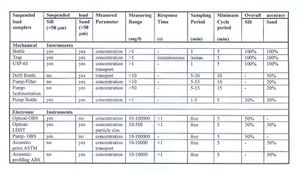Instrument characteristics of point-integrating suspended load samplers
The most important characteristics of the point-integrating suspended load samplers are summarized. The results are presented in Figure 1. Hereafter, some of the characteristics are discussed.
Contents
Sampling period
The sampling period is the time period during which a sample is collected. For the bottle-type and trap-type samplers the sampling period is equal to the filling period of the bottle or trap. The sampling period of the Delft Bottle is restricted by the size of the sediment catch which should be small compared with the size of the sedimentation chamber of the instrument. The sampling period of the pump-filter sampler is restricted by the filter characteristics. A small 50 um-filter may be blocked rather easily, especially in a silty environment. The sampling period of the optical and acoustical samplers is free. For time-averaging additional equipment should be used allowing a digital reading.
Minimum cycle period
The minimum cycle period is the minimum time period between two successive measurements at adjacent points in a vertical. In case of a free sampling period a minimum sampling period of about 5 minutes is used to obtain the minimum cycle period, as given in Figure 1. The cycle period can be used to evaluate the time period needed to cover a full concentration profile measurement. In case of tidal flow conditions this latter period should be small in relation to the tidal period.
Overall accuracy
The overall accuracy is an estimate of the overall error of a single measurement due to (systematic and random) measuring errors and stochastic (fluctuation) errors related to the physical process. The latter errors are introduced by the stochastic fluctuations of the physical parameters to be measured. For example,single bottle-measurements may have an error of about 100%. This error can be reduced by using a larger sampling period or by collecting more samples. The overall accuracy of the samplers with a free sampling period, as presented in Figure 1, is based on a relatively long sampling period (say 5 minutes). The accuracy of the optical and acoustical samplers is largely dependent on the number and accuracy of the calibration samples.
Figure 1: Instrument characteristics
References
See also
Other contributions of Leo van Rijn
articles with parts of the manual
- INTRODUCTION, PROBLEMS AND APPROACHES IN SEDIMENT TRANSPORT MEASUREMENTS
- DEFINITIONS, PROCESSES AND MODELS IN MORPHOLOGY
- PRINCIPLES, STATISTICS AND ERRORS OF MEASURING SEDIMENT TRANSPORT
- COMPUTATION OF SEDIMENT TRANSPORT AND PRESENTATION OF RESULTS
- MEASURING INSTRUMENTS FOR SEDIMENT TRANSPORT
- MEASURING INSTRUMENTS FOR PARTICLE SIZE AND FALL VELOCITY
- MEASURING INSTRUMENTS FOR BED MATERIAL SAMPLING
- LABORATORY AND IN-SITU ANALYSIS OF SAMPLES
- IN-SITU MEASUREMENT OF WET BULK DENSITY
- INSTRUMENTS FOR BED LEVEL DETECTION
- ARGUS VIDEO
- MEASURING INSTRUMENTS FOR FLUID VELOCITY, PRESSURE AND WAVE HEIGHT
other articles
- Instrument Characteristics
- Guidelines instruments
- Instruments for rivers
- Instruments for estuaries
- Instruments for coasts
- bed load transport
External links
Crediting the authors
Please note that others may also have edited the contents of this article.
|
[[Category:Articles by {{{AuthorFullName}}}]]
Please note that others may also have edited the contents of this article.
|
[[Category:Articles by {{{AuthorFullName}}}]]
